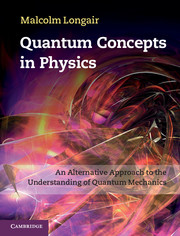Book contents
- Frontmatter
- Contents
- Preface
- Acknowledgements
- Part I The Discovery of Quanta
- Part II The Old Quantum Theory
- Part III The Discovery of Quantum Mechanics
- 10 The collapse of the old quantum theory and the seeds of its regeneration
- 11 The Heisenberg breakthrough
- 12 Matrix mechanics
- 13 Dirac's quantum mechanics
- 14 Schrödinger and wave mechanics
- 15 Reconcilingmatrix and wave mechanics
- 16 Spin and quantum statistics
- 17 The interpretation of quantum mechanics
- 18 The aftermath
- Epilogue
- Notes
- References
- Name index
- Subject index
17 - The interpretation of quantum mechanics
from Part III - The Discovery of Quantum Mechanics
Published online by Cambridge University Press: 05 February 2013
- Frontmatter
- Contents
- Preface
- Acknowledgements
- Part I The Discovery of Quanta
- Part II The Old Quantum Theory
- Part III The Discovery of Quantum Mechanics
- 10 The collapse of the old quantum theory and the seeds of its regeneration
- 11 The Heisenberg breakthrough
- 12 Matrix mechanics
- 13 Dirac's quantum mechanics
- 14 Schrödinger and wave mechanics
- 15 Reconcilingmatrix and wave mechanics
- 16 Spin and quantum statistics
- 17 The interpretation of quantum mechanics
- 18 The aftermath
- Epilogue
- Notes
- References
- Name index
- Subject index
Summary
In completing the story of spin, we have run far ahead of the continued development of the understanding of the matrix, operator and wave mechanical approaches to quantum mechanics. The reconciliation of these approaches was described in Chap. 15, but there remained the issue of the interpretation of the wavefunction and the deeper implications of the theory. The understanding came gradually with Born's interpretation of the wavefunction, Ehrenfest's demonstration of the equivalence of the classical and quantum pictures and Heisenberg's enunciation of the uncertainty principle. These led to what became known as the Copenhagen interpretation of quantum mechanics. At the same time, the formal mathematical foundations of the different approaches to quantum phenomena were set on a secure foundation thanks to the efforts of Hilbert and many others. These developments resulted in what may be referred to as the completion of quantum mechanics, in the sense that it laid the foundations for all the future development of physics at the atomic and subatomic level – some of these achievements are summarised in Chap. 18.
Schrödinger's interpretation (1926)
Schrödinger regarded wave mechanics as superior to the matrix mechanical approach to quantum physics, not only because it was based upon the well-known eigenfunction techniques of classical physics, but also because it was much more visualisable. His first attempt at interpreting the wavefunction appeared in the final Sect. 7 of the fourth part of his great series of papers (Schrödinger, 1926f) and was entitled On the physical significance of the field scalar.
- Type
- Chapter
- Information
- Quantum Concepts in PhysicsAn Alternative Approach to the Understanding of Quantum Mechanics, pp. 343 - 367Publisher: Cambridge University PressPrint publication year: 2013



